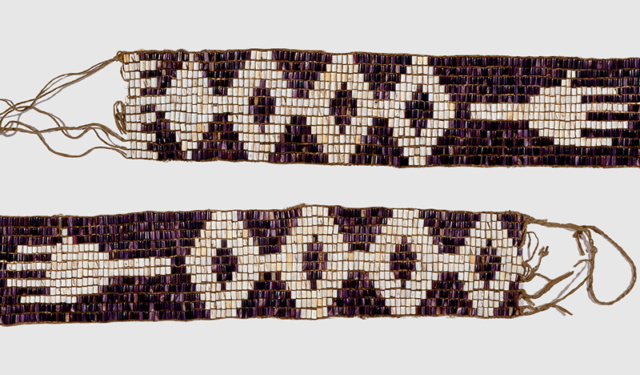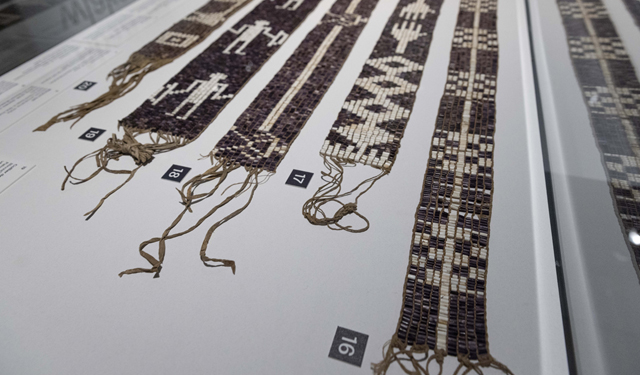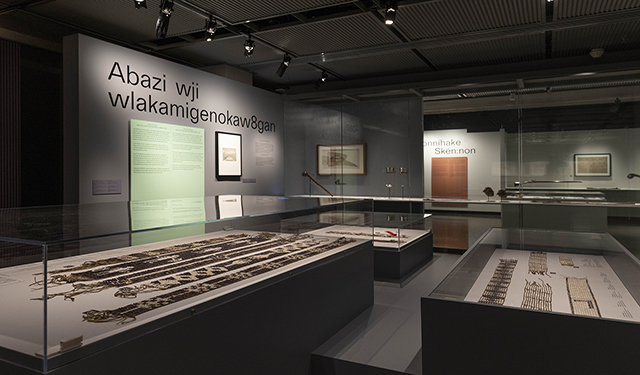[Day 2] International Symposium – Around Wampum: Histories and Perspectives
Six experts discuss the social, political and religious practices surrounding wampum in three seminars.
February 23, 2024
Capitalizing on the unprecedented interest generated by Wampum: Beads of Diplomacy, the Museum is organizing a symposium on February 22 and 23, 2024 devoted to these cultural objects, bringing together a dozen Indigenous, Quebecois, Canadian and international specialists.
These experts from various fields of research and intervention, will discuss the social, political and religious practices surrounding wampum in six seminars, presented over two days, through the prism of their multidisciplinary perspectives.
This recording includes the talks and the three panels from February 23, 2024. View the day’s program below, and browse the video using the available chapters to watch the session of your choosing.
Program – Day 2
| Panel 1 – Wampum in the Era of the Atlantic Revolutions | Moderated by Catherine Desbarats, McGill University, Canada | “Creative Uses of Wampum and Anglo-Haudenosaunee Diplomacy: Three Eighteenth-Century Case Studies,” Elizabeth Elbourne, McGill University, Canada
“The Washington Covenant Belt: Historic and Contemporary Interpretations of Haudenosaunee Wampum,” Darren Bonaparte, Saint Regis Mohawk Tribal Historical Preservation Officer, Awkwesasne, Canada |
| Panel 2 – The Materiality of Wampum | Moderated by Jonathan Lainey, McCord Stewart Museum, Canada | “The Spirit of My Words”: Anishinaabe Understandings of Wampum,” Alan Corbiere, York University, Canada
“Belts, Strings, and Paper Wampum: A Legal History of Wampum in Anishinaabe-Crown Councils,” Heidi Bohaker, University of Toronto, Canada |
| Panel 3 – Perspectives on Transatlantics Wampum | Moderated by Jean-François Lozier, Canadian Museum of History, Canada | “Seeing Like a Conquering State: French Archives vs. Wampum Belts in the New British Regime,” Riley Wallace, McGill University, Canada
“Wampum in Canadian Courts,” Jacynthe Ledoux, lawyer, Cain Lamarre, Canada |
| Elder talk | Verna McGregor, Kitigan Zibi Anishinabeg, Canada |
Panel 1
CREATIVE USES OF WAMPUM AND ANGLO-HAUDENOSAUNEE DIPLOMACY: THREE EIGHTEENTH-CENTURY CASE STUDIES
Elizabeth Elbourne, McGill University, Canada [5:19 ]
Broadly, the paper will explore creative uses of wampum (including the refusal to acknowledge wampum) in Anglo-Haudenosaunee interactions in late eighteenth-century colonial America. The paper will draw on three examples related to struggles over land, negotiations with the Society for the Propagation of the Gospel, and the warfare of the American Revolution. The paper will argue that settler interlocutors also tried to use wampum, albeit in limited ways, in interactions with the Haudenosaunee and that gestures around the use or even deliberate distortion of wampum were part of a language of limited and fragile exchange.
Le wampum d’alliance de Washington : interprétations historiques et contemporaines d’un collier haudenosaunee
Darren Bonaparte, Saint Regis Mohawk Tribal Historical Preservation Officer, Awkwesasne, Canada [32:05 ]
In 2020, ethnologist William Starna asked Darren Bonaparte and Randy A. John to co-author a paper with him about a legendary wampum belt held by the Haudenosaunee Confederacy. The Washington Covenant Belt, as it is commonly known, is one of the wampum artifacts repatriated from the New York State Museum. One of the goals was to determine when the confederacy received this belt from the first president of the United States. In his presentation, Darren discusses the historic and contemporary interpretations of this belt and the research team’s conclusions.
Panel 2
“THE SPIRIT OF MY WORDS”: ANISHINAABE UNDERSTANDINGS OF WAMPUM
Alan Corbiere, York University, Canada [1:21:10 ]
Drawing from council proceedings written in English, petitions written in Anishinaabemowin, museum collections, and ethnographies, this presentation interrogates the relationship between metaphoric diplomatic language and its relationship to the visual symbolism and materiality of wampum strings and wampum belts. Recognizing that wampum was used over a vast area by many nations, this presentation adopts an Anishinaabe perspective and will situate Anishinaabe wampum use within this diplomatic world. This presentation is part of a larger research project that is investigating meaning-making and the development of shared understanding amongst different nations in the Great Lakes area and adjacent environs.
BELTS, STRINGS, AND PAPER WAMPUM: A LEGAL HISTORY OF WAMPUM IN ANISHINAABE-CROWN COUNCILS
Heidi Bohaker, University of Toronto, Canada [ 1:47:57]
Between the Seven Years’ War and end of the War of 1812 in 1815, leaders of Anishinaabe council fires and British Crown officials met regularly in formal councils and exchanged a staggering amount of wampum belts and strings as they resolved differences and renewed their alliance relationships. The gifting of belts and strings is also recorded in the minutes associated with some of the early pre-Confederation land purchases between Anishinaabe peoples and the Crown, and on later petitions described as “paper wampum.” This talk discusses some examples of different uses and meanings of wampum in Anishinaabe-Crown councils, including the stated intention of the party gifting the wampum, and the expectations or obligations placed of the recipients, to better understand the specific use of wampum in Crown treaty negotiations.
Panel 3
SEEING LIKE A CONQUERING STATE: FRENCH ARCHIVES VS. WAMPUM BELTS IN THE NEW BRITISH REGIME
Riley Wallace, McGill University, Canada [ 2:29:19]
Following the Conquest of Quebec, British officials faced Indigenous and Canadian claims to land which, in the case of the Sulpicians and Kanesatake in the 1780s, relied on different kinds of records. As Jonathan Lainey has shown, the colonial government sided with the Sulpician missionaries’ use of archival documents over Kanesatake’s use of a wampum belt to claim the seigneurie of Lac des Deux Montagnes. The Two-Dog Wampum case reveals the dubious legal value of wampum in the minds of the British government following the Conquest—an assessment that has had a long afterlife in Canadian courts. This presentation builds from the Two-Dog Wampum case to provide greater context surrounding the ascendancy of archives over wampum in the eyes of the emerging British colonial state. It does so in part by investigating the construction and use of what would be dubbed “ancient French archives.”
WAMPUM IN CANADIAN COURTS
Jacynthe Ledoux, lawyer, Cain Lamarre, Canada [ 2:52:37]
Wampum belts are invoked by several Indigenous peoples as bearing legal principles of a constitutional nature. Since the early 1980s, various wampums have been presented by Indigenous parties in support of legal or factual allegations in over thirty cases decided by Canadian courts. An analysis of these decisions provides a portrait of the quality of the interactions between the Indigenous and state legal orders, and feeds into a more fundamental reflection on the limits of the policy of recognition in the context of Canadian multijuralism.
Elders
Verna McGregor
Allocution by Verna McGregor, Kitigan Zibi Anishinabeg, Canada [ 3:38:32]
Verna McGregor is Algonquin – Omamawinini (Northeastern Algonquin which includes the Ottawa River watershed). She lives in the Kitigan Zibi Anishinabeg First Nation with her son and grandson. She has worked with Elders throughout the years to plan traditional gatherings including language symposiums. Her relative is the former keeper of the original wampum belts in the community, Elder William Commanda. Her mother would also sit with the former keeper of the belts prior to William Commanda, Elder Theresa Meness. Elder Meness was steadfast in affirming the Jay Treaty Belt by attending the annual Border Crossing Celebrations during her lifetime.
In the last number of years, Verna and her son (Sheldon McGregor) and brother (Fred McGregor) would meet with Professor Margaret Bruchac and Dr. Lise Puyo from the University of Pennsylvania in their research on the Lake of Two Mountains Belt, which is currently housed at the Vatican Museum. In 2016, Verna and her son Sheldon McGregor were requested by the community Elders, as part of protocol, to hold a welcoming ceremony for various sacred items that were being brought from other First Nations into the traditional lands for display at the National Gallery of Canada. The sacred items formed part of the Indigenous exhibit for Canada’s 150-year anniversary of Confederation (1867-2017). The exhibit included wampum which was part of Verna’s wampum journey.
MODERATORS
Catherine Desbarats
Associate Professor, Chair of the Department of History, McGill University. As a specialist on New France, she has long taught a course on Indigenous peoples and the early modern French empire. While director of McGill’s Quebec Studies program, she taught an interdisciplinary course on the Indigenous experience in Quebec that inspired the symposium, and subsequently the book: Les Autochtones et le Québec. Des premiers contacts au Plan Nord, edited by Alain Beaulieu, Stéphan Gervais and Martin Papillon, and published in Montreal by Presses de l’Université de Montréal, 2013.
Aaron Mills
Aaron Mills (JD Toronto, LLM Yale, PhD UVic) is an Anishinaabe from Couchiching First Nation in Treaty #3. He has spent much of the last 15 years learning about Anishinaabe law in community, on the land, and through stories. Guided by his circle of elders, Aaron works to conceptualize Indigenous law on its own terms. He is frequently called on by Indigenous communities to support their efforts in revitalizing their systems of law. Aaron joined McGill Law as an Assistant Professor in 2018 and is the Canada Research Chair in Indigenous Constitutionalism and Philosophy.
Yann Allard-Tremblay
Yann Allard-Tremblay is assistant professor in the department of political science at McGill University. He is a member of the College of New Scholars, Artists and Scientists of the Royal Society of Canada. He holds a PhD in Philosophy from the Universities of St Andrews and Stirling. His current research in political theory is focused on the decolonization and Indigenization of political theory. His research has recently featured in the Canadian Journal of Political Science, Constellations, and Political Studies. He is a member of the Huron-Wendat First Nation.
SPEAKERS
Elizabeth Elbourne
Elizabeth Elbourne is an Associate Professor in the Department of History and Classical Studies, McGill University. Her recent publications include Empire, Kinship and Violence: Family Histories, Indigenous Rights and the Making of Settler Colonialism, 1770-1842 (Cambridge University Press, 2022). Past publications include Blood Ground: Colonialism, Missions and the Contest for Christianity in Britain and the Eastern Cape, 1799-1852 (McGill-Queens, 2003). She is currently co-editor, with Dr. Shino Konishi, of a volume covering 1750-1914, in the forthcoming five-volume Cambridge History of Colonialism and Decolonization (Cambridge University Press).
She served as Joint Editor in Chief, with Dr. Brian Cowan, of the Journal of British Studies, from 2010 to 2015. She is currently working on a history of hunting and the British empire’s relationship to hunters, including debates over the land rights of Indigenous hunters, big game hunting and violence between farmers and hunters.
Darren Bonaparte
Darren Bonaparte is an author and researcher who has worked for Akwesasne’s governments, cultural centers, and media organizations. He is the creator of the Wampum Chronicles, a website dedicated to Mohawk history. He was elected to the Mohawk Council of Akwesasne in 2000 and currently serves as the Director of the Tribal Historic Preservation Office of the Saint Regis Mohawk Tribe.
He is co-author (with Rosemary Bonaparte) of The History of the St. Regis Catholic Church (1998), and author of Creation & Confederation: The Living History of the Iroquois (2005), A Lily Among Thorns: The Mohawk Repatriation of Káteri Tekahkwí:tha (2009), and An Early History of Akwesasne: The Works of Franklin B. Hough (2020). In 2018, he wrote the libretto for Indigenous Visions & Voices, a concert composed by Barbara Croall (Odawa) and performed by the McGill Chamber Orchestra. He was a historical and cultural consultant for The War That Made America (2006), FBI: Most Wanted (2020), and Outlander (2018-2019).
Alan Corbiere
Dr. Alan Ojiig Corbiere, Bne doodem (Ruffed Grouse clan), is an Anishinaabe from M’Chigeeng First Nation on Manitoulin Island. He was educated on the reserve and then attended the University of Toronto for a Bachelor of Science, he then entered York University and earned his Master’s of Environmental Studies. During his master’s studies he focused on Anishinaabe narrative and Anishinaabe language revitalization. For five years he served as the Executive Director at the Ojibwe Cultural Foundation (OCF) in M’Chigeeng, a position which also encompassed the roles of curator and historian.
He also served as the Anishinaabemowin (Ojibwe) Revitalization Program Coordinator at Lakeview School, M’Chigeeng First Nation, where he and his co-workers developed a culturally based second language program that focused on using Anishinaabe stories to teach language. He defended his PhD thesis in 2020 and is now an Assistant Professor in the History Department at York University. He currently holds a Tier 2 Canada Research Chair in Indigenous History of North America.
Heidi Bohaker
Heidi Bohaker investigates on the history of Indigenous-Crown relations, treaties and federal and provincial government policies toward Indigenous peoples in Canada. She teaches graduate and undergraduate courses in treaty history, the history of residential schools in Canada and Canadian legal history. As a co-director of GRASAC, the Great Lakes Research Alliance, she also studies Great Lakes cultural heritage stored in museums and archives around the world and seeks ways to reconnect that heritage to Great Lakes First Nations.
Riley Wallace
Riley Wallace is a doctoral candidate in the Department of History and Classical Studies at McGill University. His interests in imperial state formation and moments of regime change drew him to study the role of French archives as sites of political legitimacy in post-Conquest Quebec. His in-progress dissertation (Archives, Governance, and the Politics of Information in post-Conquest Quebec, 1759-1791) is funded by SSHRC and FRQSC doctoral fellowships.
Jacynthe Ledoux
Jacynthe Ledoux is a member of the Bar in Quebec and Ontario. She specializes in Indigenous law and has represented First Nations in environmental law, specific claims, energy law, natural resources, constitutional law, youth protection and human rights cases.
Ms. Ledoux holds a master’s in Canadian common law from Osgoode Hall Law School, a master’s in environmental law from McGill University, and bachelor’s degrees in law and international studies, both from Université de Montréal. Her dissertation, which explores the interactions between state and Indigenous legal orders through the prism of wampum-related case law, won the prize for best dissertation in Quebec law.



